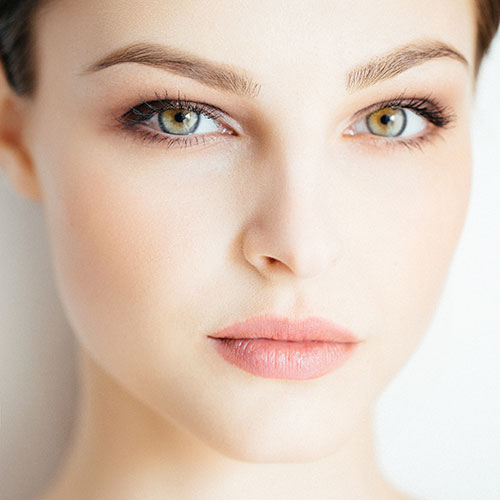Lateral temporal subcutaneous lift

What is lateral temporal subcutaneous lift surgery?
Lateral temporal subcutaneous lift, also known as a ‘ponytail lift’ or a ‘temporal lift’ is designed to reduce sagging skin around the peri-orbital region, addressing the upper face, top of the cheekbone to the tail of the eyebrow.
By making a small incision along the hairline near the temporal region, the lateral temporal subcutaneous lift will be able to redrape the skin and tissue in the outer third of the brow area, near the tail of the eyebrow and reposition it slightly higher to smooth out wrinkles and improve the overall appearance of the temple area, without excess tension.
Why consider lateral temporal subcutaneous lift surgery?
Dropping of the brow and tail of the eyebrow generally occurs due to ageing changes in the face and can occur alongside drooping of the upper eyelid and a loss of elasticity and volume in the peri-orbital region.
The lateral temporal subcutaneous lift may be suitable for patients who want to achieve a more youthful and refreshed appearance of the upper part of the face, with minimum downtime and scarring. This procedure is often considered by patients who are looking to refresh the result of their previous face lift surgery.
For ultimate upper face rejuvenation, some patients opt to have the lateral temporal subcutaneous lift in conjunction with blepharoplasty, fat transfer to orbital area (eyebrow, temple and cheekbone) and nano fat to the under eyes.
For ultimate upper face rejuvenation, some patients opt to have the lateral temporal subcutaneous lift in conjunction with blepharoplasty, fat transfer to orbital area and nano fat to the under eyes.

Did you know?
WHAT HAPPENS DURING lateral temporal subcutaneous lift SURGERY?
During the operation, sagging and excess skin in the peri-orbital region will be removed and redraped towards the hairline to create tension, giving the skin a firmer, more youthful appearance.
What areas can be addressed?
The lateral temporal subcutaneous lift can:
- Raise the outer part of the eyebrows
- Reduce wrinkles and folds on the forehead and at the corners of the eyes
- Enhance the outer part of the forehead
- Reduce excess skin on the upper eyelids
- Open and rejuvenate the eyes
- Improve sagging and drooping skin on the peri-orbital region
How does lateral temporal subcutaneous lift differ to mini lower face and neck lift?
The small face lift and mini lower face and neck lift do not have much action on the upper part of the face. By making a small incision along the hairline near the temporal region, the lateral temporal subcutaneous lift will be able to redrape the skin and tissue in the outer third of the brow area, near the tail of the eyebrow and reposition it slightly higher to smooth out wrinkles and improve the overall appearance of the temple area, without excess tension.
WHEN CAN I SHOWER AND WASH MY HAIR AFTER lateral temporal subcutaneous lift SURGERY?
In general, you may gently shower and wash your hair 48 hours after surgery, taking particular care on the treated areas. You can also blow dry your hair on a cool setting. Be gentle when brushing or combing your hair so that you do not catch your comb in the suture lines.
WILL I HAVE OBVIOUS SCARS FOLLOWING lateral temporal subcutaneous lift SURGERY?
There will be scars from the surgery, but both incisions will be hidden in the hairline. The scars will usually be red at first, then purple, and then fade to become paler over 12 months.
WHERE WILL THE INCISIONS BE POSITIONED?
The incisions are almost completely hidden in the hairline near the temple region.
HOW LONG DOES lateral temporal subcutaneous lift SURGERY TAKE?
The operation can take between 60-90 minutes.
WHAT FORM OF ANAESTHETIC WILL BE USED?
All facial procedures are performed by Mr Olivier Amar as day surgery. Blepharoplasty surgery is performed under total intravenous anaesthesia (TIVA), a technique of anaesthesia which uses a combination of agents given exclusively via the intravenous route without the use of gas anaesthesia. This means you will sleep comfortably throughout the procedure and wake immediately afterwards with a significantly reduced likelihood of feeling groggy or nauseous. The anaesthesia will be explained to you by your anaesthetist during the preoperative consultation. Having surgery under TIVA allows you to go home the same day to rest and recuperate in comfort.
How can I compliment my overall result?

Express PRP treatment
The goal of PRP treatment is to rejuvenate your skin and encourage new collagen.
read
What can I expect after lateral temporal subcutaneous lift surgery?
Initially you can expect to experience mild pain and discomfort, which can be managed by a pain killer prescription. You may experience some itching and numbness around the incision sites as you heal. You can expect bruising and swelling for between two and three weeks following surgery.
It is better to keep your head up to reduce swelling. In particular, sleep with extra pillows to keep your head raised for the first few days after surgery.
You will be asked to come in for a post-operative nurse appointment at 7 days and 12 days after your surgery. At this point your incision sites will be reviewed, every other stitch removed and your preliminary healing will be assessed. The remaining stitches will be removed at your second post-operative nurse appointment. You will come back at six week after surgery to be reviewed by Mr Olivier Amar.
How long do I have to wait to return to normal activities following the surgery?
Patients who undergo facial procedures usually return to normal activities after a week to ten days. I recommend patients return to gentle exercise as soon as they feel comfortable to do so – but nothing strenuous for three weeks after surgery.






